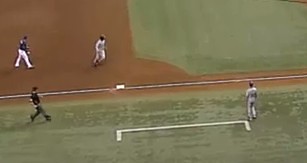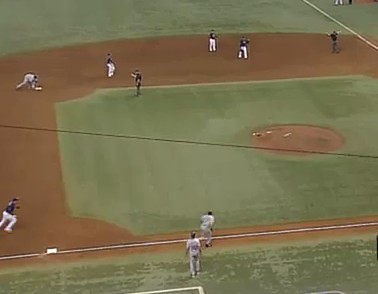NLCS Game Five Review: San Francisco
Game Five obviously did not go the way the Giants wanted, as the 4-2 loss cut their series lead to 3-2. There are small signs that the Phillies’ hitters are coming around, and the pitching matchups aren’t going to get any more favorable for San Francisco. I won’t review every key play of Game Five, but rather a few bad and good points that the Giants can take away from it.
Errors in last night’s game highlighted problems some see with the Giants infield defense. Aubrey Huff‘s error in the third inning was the biggest WPA shift in the game (.155), scoring two runs to put the Phillies up for good. Pablo Sandoval’s error in the ninth didn’t cost the Giants any runs, but did serve as a reminder that he has been benched for reasons other than his bad season at the plate. Despite Huff’s good UZR and DRS scores this season, for his career he’s still a negative defender at both at first, and was slightly below average in 2010’s Fans Scouting Report. The metrics don’t see Sandoval as horrible at third base, but the Giants are clearly concerned about his abilities there.
The middle of the Giants’ batting order got shut down. There’s no shame in getting reigned in by Roy Halladay, even when he’s working with a pulled groin, but the Giants needed more from their 3-4-5 hitters Aubrey Huff, Buster Posey, and Pat Burrell, who were held to a double (by Burrell) and a walk (by Posey) in twelve plate appearances. It was obvious before the series started that runs would be hard to come by for both teams, especially the Giants, but the team can’t count on Cody Ross to keep bailing them out (insert baserunning joke here).
There were some hopeful signs for the Giants, however. They still aren’t being dominated by the Phillies’ offense. Tim Lincecum gave up three runs (not horrible in itself over seven innings), but two of those scored on Huff’s error. The Phillies did look better at the plate in this game (at least to me), but they are still struggling to score runs. Lincecum won’t be starting the other games of the series, but Jonathan Sanchez and Matt Cain have more than held their own so far against the Phillies. One long home run by Jayson Werth doesn’t change that.
Despite the last night’s defensive foibles, Giants fans should be happy that Pablo Sandoval started last night and got a hit. He grounds into an incredible number of double plays, and 1-4 with no walks isn’t great, but he’s still a better bet than running either Mike Fontenot or Edgar Renteria out there. Bruce Bochy resisted the temptation to leave Andres Torres on the bench, and he responded by going 2-3 with a walk. Another poor plate performance shouldn’t change our evaluation of his true talent, but it might have put pressure on Bochy to sit him for the remainder of the series, and he’s clearly better both offensively and defensively than Aaron Rowand. It is amazing how much I’ve read about Torres’ “returning to reality” during his playoff struggles from people who should know better. He’s probably not as good offensively as his 2009 and 2010 regular season performances, but as I’ve discussed before, this hasn’t been a 300 PA, BABIP-fueled hot streak, either. For more than 700 PA in 2009 and 2010 Torres has had an above-average walk rate and good power. He needs to be starting every game for the Giants.
Some will want to talk about the Phillies “seizing the momentum” as the series shifts back the Philadelphia. The Phillies still have the more talented group of players, but they certainly haven’t outplayed the Giants so far in this series. Even in last night’s loss, the Giants showed that if they do win the series it won’t be a miraculous feat.









